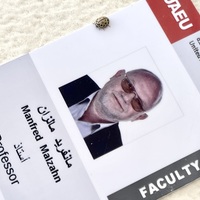Talks by Chris Forstall
The Tesserae Project has created a freely available web tool for analyzing text reuse (intertextu... more The Tesserae Project has created a freely available web tool for analyzing text reuse (intertextuality) that automatically identifies matching two-word phrases (bigrams) in Latin poets using one of two search algorithms. Comparison with the results of traditional scholarship demonstrates the efficacy, current limitations, and potential of this approach. Automatic bigram matching by morphological form and dictionary headword detects a significant number of parallels identified by traditional methods. Results so far do not fully replicate traditional scholarship, but the incorporation of further feature sets holds the potential of approaching this standard. Bigram detection produces more systematic results, permits large-scale intertextual study, and identifies less conspicuous parallels.
Papers by Chris Forstall

Digital Scholarship in the Humanities, 2022
Open Access: https://academic.oup.com/dsh/advance-article/doi/10.1093/llc/fqac006/6549220
The ... more Open Access: https://academic.oup.com/dsh/advance-article/doi/10.1093/llc/fqac006/6549220
The DICES research group reports here on preliminary work to integrate research on Greek and Latin epic speeches into the larger ecosystem of linked open data (LOD) for classical scholarship. The ability to collate speech data from different researchers and to leverage external repositories of texts and characters opens up new possibilities for interrogation of the epic corpus. We briefly survey the current state of scholarship on epic speeches and of the digital infrastructure on which we propose to build. We outline a model for harmonizing speech data across studies and aligning it with existing LOD standards. Finally, we discuss some early proof-of-concept results and the larger implications of this approach for the field. The long-term aim of the DICES project is to build a database of metadata on direct speech in Greek and Latin epic, not only covering canonical texts such as Homer and Virgil, but also including the less-studied texts of the late antique period, which will benefit greatly both from the increased accessibility and also from the diachronic perspective afforded by a corpus-based approach. The envisioned database also has the potential to include diachronic data from additional genres and languages at a later stage.
Lucan and Claudian: Context and Intertext, 2016
Machine learning approaches to authorship and stylistic analysis have been very popular in the pa... more Machine learning approaches to authorship and stylistic analysis have been very popular in the past few years. In Abassi and Chen's work, 2 C.45, a powerful decision tree classifier is used to identify and track authors on message boards frequented by extremists. Neural Networks have also been quite popular in this problem domain, as demonstrated in the work of Luyckx and Daelemans, 3 whereby the authors use "shallow features," those features at the token, lexical, and syntactical levels as input units to their neural net. Both C.45 and Neural Networks show promise, but are consistently outperformed by Support Vector Machines, which, unlike the previous two techniques, are able to efficiently process hundreds of thousands of features.
Literary and Linguistic Computing, 2011
In this study we use computational methods to evaluate and quantify philological evidence that an... more In this study we use computational methods to evaluate and quantify philological evidence that an eighth century CE Latin poem by Paul the Deacon was influenced by the works of the classical Roman poet Catullus. We employ a hybrid feature set composed of n-gram frequencies for linguistic structures of three different kinds-words, characters, and metrical quantities. This feature set is evaluated using a one-class support vector machine approach.
Transactions of the American Philological Association, 2012
University at Buffalo, SUNY When does Vergil refer to the work of another author, and what does i... more University at Buffalo, SUNY When does Vergil refer to the work of another author, and what does it mean? Variations of this question have been asked about a range classical works from the height of Alexandrian scholarship in the 3 rd century BCE to our own day. Formulations have changed, from ancient notions of imitation, emulation, and theft, to the modern emphasis on artistic repurposing and concerns with the ontological status of textual connections. 2 In classical studies, Latin poetry has been the subject of the most intensive investigation, but scholars of Greek poetry and of Greek and Latin prose have become increasingly interested in how authors reuse and refer to their predecessors and contemporaries. 3
Literary and Linguistic Computing, 2013
Tesserae is a web-based tool for automatically detecting allusions in Latin poetry. Although stil... more Tesserae is a web-based tool for automatically detecting allusions in Latin poetry. Although still in the start-up phase, it already is capable of identifying significant numbers of known allusions, as well as similar numbers of allusions previously unnoticed by scholars. In this paper we use the tool to examine allusions to Vergil's Aeneid in the first book of Lucan's Civil War.
Current CFPs by Chris Forstall
The DICES project group is currently in the process of developing a new database on direct speech... more The DICES project group is currently in the process of developing a new database on direct speeches in ancient and late antique epic with multi-year funding from the SSHRC. The new establishment of the Epic Speeches Network complements this effort and advances the DICES initiative’s goal to stimulate and facilitate innovative research on direct speech representation in Greek and Roman epic by combining a variety of computational methods with theoretical models from narratology, discourse analysis, and linguistics. The first product of our collaborative research efforts will be a peer-reviewed edited volume showcasing new possibilities for diachronic analysis of direct speech and related categories in the epic tradition from Homer to Late Antiquity.











Uploads
Talks by Chris Forstall
Papers by Chris Forstall
The DICES research group reports here on preliminary work to integrate research on Greek and Latin epic speeches into the larger ecosystem of linked open data (LOD) for classical scholarship. The ability to collate speech data from different researchers and to leverage external repositories of texts and characters opens up new possibilities for interrogation of the epic corpus. We briefly survey the current state of scholarship on epic speeches and of the digital infrastructure on which we propose to build. We outline a model for harmonizing speech data across studies and aligning it with existing LOD standards. Finally, we discuss some early proof-of-concept results and the larger implications of this approach for the field. The long-term aim of the DICES project is to build a database of metadata on direct speech in Greek and Latin epic, not only covering canonical texts such as Homer and Virgil, but also including the less-studied texts of the late antique period, which will benefit greatly both from the increased accessibility and also from the diachronic perspective afforded by a corpus-based approach. The envisioned database also has the potential to include diachronic data from additional genres and languages at a later stage.
Current CFPs by Chris Forstall
The DICES research group reports here on preliminary work to integrate research on Greek and Latin epic speeches into the larger ecosystem of linked open data (LOD) for classical scholarship. The ability to collate speech data from different researchers and to leverage external repositories of texts and characters opens up new possibilities for interrogation of the epic corpus. We briefly survey the current state of scholarship on epic speeches and of the digital infrastructure on which we propose to build. We outline a model for harmonizing speech data across studies and aligning it with existing LOD standards. Finally, we discuss some early proof-of-concept results and the larger implications of this approach for the field. The long-term aim of the DICES project is to build a database of metadata on direct speech in Greek and Latin epic, not only covering canonical texts such as Homer and Virgil, but also including the less-studied texts of the late antique period, which will benefit greatly both from the increased accessibility and also from the diachronic perspective afforded by a corpus-based approach. The envisioned database also has the potential to include diachronic data from additional genres and languages at a later stage.